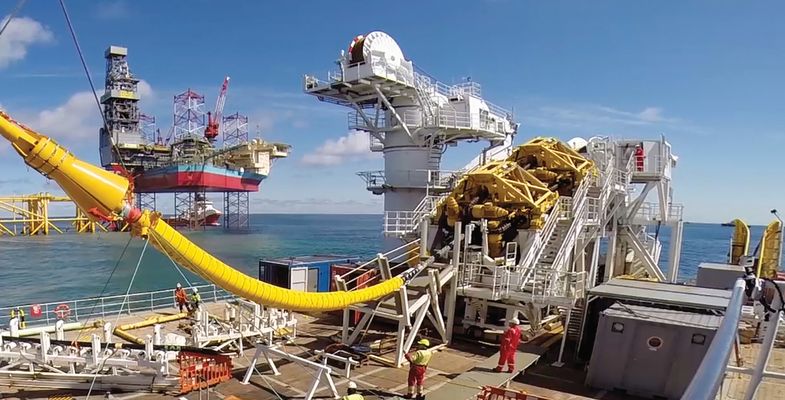IEC 60229 Insulation and Sheath Integrity Testing of Cables
The International Electrotechnical Commission (IEC) Standard IEC 60229 is a crucial guideline for ensuring the reliability, safety, and performance of electrical equipment used in harsh environments such as offshore platforms. This standard covers insulation and sheath integrity testing to ensure that cables can withstand various environmental stresses and continue to function effectively under demanding conditions.
The primary focus of IEC 60229 is on the physical properties of cable insulation, including mechanical strength, flexibility, and resistance to moisture ingress. It also addresses the integrity of the sheath, which protects the cable from external factors like abrasion and chemical exposure. The standard is particularly relevant for subsea cables used in offshore wind farms, oil and gas platforms, and other marine applications.
Compliance with IEC 60229 ensures that manufacturers and operators can trust the quality of their products and systems. This reliability is critical in industries where downtime or failure could result in significant financial loss, environmental damage, or even safety hazards. By adhering to this standard, organizations can demonstrate their commitment to maintaining high-quality standards within the energy sector.
The testing protocols outlined in IEC 60229 are designed to simulate real-world conditions that cables might encounter during operation. This includes exposure to saltwater, temperature variations, and mechanical stresses. The tests are stringent but necessary for ensuring that the insulation and sheath materials can perform their intended functions under these challenging circumstances.
IEC 60229 testing involves a series of mechanical and electrical tests aimed at evaluating the performance of cable insulation and sheathing. These tests include, but are not limited to:
- Flexibility Tests: Cables are bent through various cycles to assess their ability to withstand repeated movement without damage.
- Tensile Strength Tests: The tensile strength of the insulation and sheath is determined by pulling on a cable sample until it breaks. This ensures that the cable can endure the forces exerted during installation and operation.
- Moisture Penetration Tests: Samples are exposed to water immersion or high humidity conditions, followed by drying periods, to evaluate their resistance to moisture ingress.
- Thermal Cycling Tests: Cables undergo rapid temperature changes between extremes to check for thermal expansion and contraction that could lead to damage over time.
The results of these tests are meticulously documented in compliance reports, which serve as evidence that the cable meets or exceeds IEC 60229 requirements. These reports are essential for quality assurance, regulatory compliance, and insurance purposes.
IEC 60229 testing is particularly important for ensuring the longevity and reliability of cables used in offshore platforms. The harsh marine environment poses unique challenges that standard land-based cables do not face. By adhering to this standard, cable manufacturers can produce products that are robust enough to withstand these environmental stresses.
In conclusion, IEC 60229 is a vital standard for ensuring the safety and reliability of electrical equipment used in offshore platforms. Its focus on insulation and sheath integrity testing ensures that cables can perform their functions effectively under challenging conditions. Compliance with this standard demonstrates a commitment to quality and reliability, which is essential for maintaining high standards within the energy sector.
Applied Standards
The application of IEC 60229 testing aligns perfectly with the stringent requirements set by various international standards. The primary standard here is IEC 60229, which specifically addresses insulation and sheath integrity in cables used in harsh environments. This includes not only offshore platforms but also subsea installations.
IEC 60229 covers a range of tests that are essential for ensuring the reliability and safety of electrical equipment in offshore applications. Some key standards include:
- IEC 60228-1: This part of IEC 60228 provides general requirements for subsea power cables, which are critical components in offshore renewable energy installations.
- ISO 9457:2003: This standard deals with the testing and evaluation of electrical insulation used in cables, ensuring that it meets stringent quality control measures.
- ASTM D1894-16: This American Society for Testing and Materials (ASTM) standard provides guidelines for the determination of the mechanical properties of extruded thermoplastic sheath materials for power cables, which is essential for subsea cable integrity.
The application of these standards ensures that the testing process is comprehensive and consistent with industry best practices. Compliance with IEC 60229 not only meets regulatory requirements but also enhances the reputation of manufacturers by demonstrating a commitment to quality and reliability.
Scope and Methodology
The scope of IEC 60229 testing encompasses various aspects of cable insulation and sheath integrity, ensuring that cables meet stringent performance criteria. The methodology involves a series of tests designed to evaluate the physical properties of the cable under simulated real-world conditions.
One key aspect of the test is the flexibility test, which assesses the ability of the cable to withstand repeated bending without damage. This is crucial for cables used in environments where movement is frequent, such as on offshore platforms or during installation processes.
Tensile strength tests are also critical, evaluating the mechanical robustness of both the insulation and sheath materials. These tests involve applying controlled tension until the cable breaks, providing a clear measure of its durability.
Moisture penetration tests simulate exposure to saltwater environments by immersing samples in water for extended periods before drying them out. This helps determine how effectively the cable can resist moisture ingress, which is vital for preventing corrosion and ensuring long-term performance.
Thermal cycling tests expose cables to rapid temperature changes between extremes, simulating the thermal stresses they might encounter during operation. These tests are essential for evaluating the resilience of the cable materials against thermal expansion and contraction.
The results of these tests are meticulously recorded in compliance reports, which serve as evidence of the cable’s adherence to IEC 60229 standards. These reports are invaluable for quality assurance, regulatory compliance, and insurance purposes.





